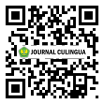SPEECH ACT USED BY NADIM MAKARIM, THE MINISTER OF EDUCATION, CULTURE, RESEARCH, AND TECHNOLOGY ABOUT INDEPENDENT LEARNING POLICY
DOI:
https://doi.org/10.37301/culingua.v2i3.99Keywords:
speech act, Nadiem Makarim, pragmaticsAbstract
This research was motivated by the use of simple, straightforward, and familiar language as well as an open communication pattern through various discussions and talks by Nadim Makarim (henceforth NM) in launching and conveying his policies as Minister of Education and Culture. On that basis, it is worth studying the speech acts used by NM in the Merdeka Learning program so that it can be implemented quickly by the implementers and users and has a positive impact on the implementation of the policies it makes. Therefore, this study aims to explain and analyze, (1) types of speech acts; (2) speaking strategy; and (3) implicature speech acts used in NM's talks and discussions as Minister of Education and Culture. This type of research is qualitative with a descriptive method. The data in this study are the utterances or sentences conveyed in the 2019 National Teacher's Day talk and the 3 Episodes of the Merdeka Learning policy discussion. The data source of this study was taken from the Youtube channel of the Ministry of Education and Culture of the Republic of Indonesia. The results of this study are as follows. First, five types of speech act used by NM in the discussion and discussion of the Merdeka Learning policy, namely (a) representative, (b) directive, (c) expressive, (d) commissive, and (e) declarative; dominant speech acts were found to be representative, (state, mention, explain and report); and the dominant locus was found to explain. Second, the three speaking strategies used by NM, namely (a) TTBB, (b) TBKP, and (c) TBKN, were dominated by the TBKP speaking strategy. Third, there are two speech act implicatures used by NM, namely (a) conventional implicatures and (b) implicatures in the use of the figure of speech, the forms of the figure of speech contained are metaphor, tutology, rhetoric, and meiosis; The dominant implicature found is implicature in the use of the figure of speech, namely with tutology figure of speech. The implications of this research, for the world of education, are targeting (1) school units, namely changing the education system in schools, changing the National Examination, the effectiveness of zoning, providing easy sharing of BOS funds; (2) higher education units, in SKS, universities must do a lot of collaboration-collaboration with companies, facilitating the accreditation system; and (3) Teachers/Lecturers, improve the quality of learning, creative, innovative, varied; do a lot of discussions; understand IT.
References
Altikriti, S. F. (2011). Speech Act Analysis to Short Stories. Academy Publisher Manufactured in Finland, 2(6), 1374–1384. https://doi.org/10.4304/jltr.2.6.1374-1384
Ad-darraji, H. H. A., Chow, T., Foo, V., Abdul, S., Mohamed, M., & Deny, G. (2012). Offering as a Comissive and Directive Speech Act?: Consequence for Cross-Cultural Communication. International Journal of Scientific and Research Publication, 2(3), 1–6.
Agustina. (1995). Pragmatik dalam Pengajaran Bahasa Indonesia. Padang: IKIP Padang.
Altikriti, S. (2016). Persuasive Speech Acts in Barack Obama’s Inaugural Speeches (2009, 2013) and The Last State of the Union Address (2016). International Journal of Linguistics, 8(2), 47–66. https://doi.org/10.5296/ijl.v8i2.9274
Arani, S. S., & Tefl, M. A. (2012). A Study of Directive Speech Acts Used by Iranian Nursery School Children: The Impact of Context on Children’s Linguistic Choices. International Journal of Applied Linguistics & English Literature, 1(5), 163–175. https://doi.org/10.7575/ijalel.v.1n.5p.163
Austin, J. L. (1984). How to do thing with word. Oxford: Oxford University Press.
Bayat, N. (2013). Akdeniz Language Studies Conference 2012. Procedia - Social and Behavioral Sciences, 70, 213–221. https://doi.org/10.1016/j.sbspro.2013.01.057
Brown, P., & Levinson, S. C. (1987). Politeness: Some Universals in Language Usage. Cambridge: Cambridge University Press.
Grice, H. (1975). Logic and Coverssation. In C. Peter & J. Morgan (Eds.), Sintax and Semantics: Speech Act. Akademi Press.
KBBI. (2020). Kamus Besar Bahasa Indonesia (KBBI). [Online] Availabe At: http://kbbi.web.id/
Leech, G. (1993). Prinsip-Prinsip Pragmatik. UI Press.
Mahsun. (2007). Metode Penelitian Bahasa (Tahapan strategi, metode dan tekniknya). PT Raja Grafindo Persada.
Searle, J. R. (1976). A classification of illocutionary acts. Language in Society, 5(1), 1–23. https://doi.org/10.1017/S0047404500006837
Sudaryanto. (1993). Metode dan Aneka Teknik Analisis Bahasa. Duta Wacana University Press.
Sugiyono. (2012). Metode Penelitian Kuantitatif, Kualitatif, dan R&D. Anggota Ikatan Penerbit Indonesia (IKAPI).
Wijana, I. D. P. (1996). Dasar-dasar Pragmatik. Yogyakarta: Andi.
Wikipedia. (2020). Profil dan Biografi Nadiem Makarim. Retrieved from https://id.wikipedia.org/wiki/Nadiem_Makarim
Yule, G. (2006). Pragmatik (Terjemahan oleh Indah Fajar Wahyuni). Pustaka Belajar.
Downloads
Published
Issue
Section
License
Copyright (c) 2021 Yustitiayu Novelly, Agustina

This work is licensed under a Creative Commons Attribution 4.0 International License.









